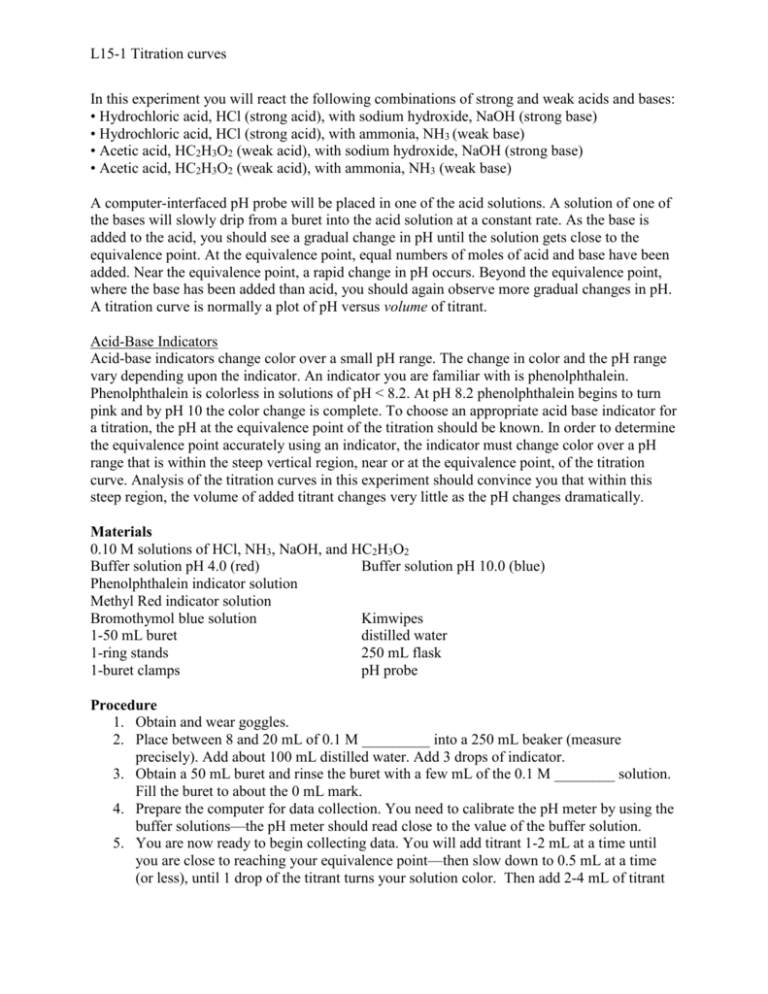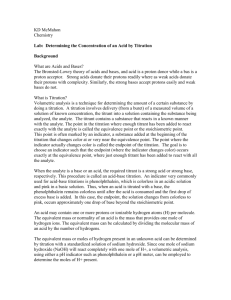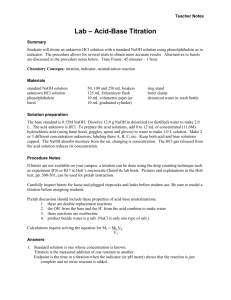L15-1 Titration curves In this experiment you will react the following
advertisement

L15-1 Titration curves In this experiment you will react the following combinations of strong and weak acids and bases: • Hydrochloric acid, HCl (strong acid), with sodium hydroxide, NaOH (strong base) • Hydrochloric acid, HCl (strong acid), with ammonia, NH3 (weak base) • Acetic acid, HC2H3O2 (weak acid), with sodium hydroxide, NaOH (strong base) • Acetic acid, HC2H3O2 (weak acid), with ammonia, NH3 (weak base) A computer-interfaced pH probe will be placed in one of the acid solutions. A solution of one of the bases will slowly drip from a buret into the acid solution at a constant rate. As the base is added to the acid, you should see a gradual change in pH until the solution gets close to the equivalence point. At the equivalence point, equal numbers of moles of acid and base have been added. Near the equivalence point, a rapid change in pH occurs. Beyond the equivalence point, where the base has been added than acid, you should again observe more gradual changes in pH. A titration curve is normally a plot of pH versus volume of titrant. Acid-Base Indicators Acid-base indicators change color over a small pH range. The change in color and the pH range vary depending upon the indicator. An indicator you are familiar with is phenolphthalein. Phenolphthalein is colorless in solutions of pH < 8.2. At pH 8.2 phenolphthalein begins to turn pink and by pH 10 the color change is complete. To choose an appropriate acid base indicator for a titration, the pH at the equivalence point of the titration should be known. In order to determine the equivalence point accurately using an indicator, the indicator must change color over a pH range that is within the steep vertical region, near or at the equivalence point, of the titration curve. Analysis of the titration curves in this experiment should convince you that within this steep region, the volume of added titrant changes very little as the pH changes dramatically. Materials 0.10 M solutions of HCl, NH3, NaOH, and HC2H3O2 Buffer solution pH 4.0 (red) Buffer solution pH 10.0 (blue) Phenolphthalein indicator solution Methyl Red indicator solution Bromothymol blue solution Kimwipes 1-50 mL buret distilled water 1-ring stands 250 mL flask 1-buret clamps pH probe Procedure 1. Obtain and wear goggles. 2. Place between 8 and 20 mL of 0.1 M _________ into a 250 mL beaker (measure precisely). Add about 100 mL distilled water. Add 3 drops of indicator. 3. Obtain a 50 mL buret and rinse the buret with a few mL of the 0.1 M ________ solution. Fill the buret to about the 0 mL mark. 4. Prepare the computer for data collection. You need to calibrate the pH meter by using the buffer solutions—the pH meter should read close to the value of the buffer solution. 5. You are now ready to begin collecting data. You will add titrant 1-2 mL at a time until you are close to reaching your equivalence point—then slow down to 0.5 mL at a time (or less), until 1 drop of the titrant turns your solution color. Then add 2-4 mL of titrant L15-1 Titration curves past the equivalence point. Swirl the flask after each volume of titrant is added. Read the pH after each amount of titrant added. 6. Watch to see if the indicator changes color before, at the same time, or after the rapid change in pH at the equivalence point. For example, if phenolphthalein is a suitable indicator for this reaction, it should change from clear to pink at about the same time as the jump in pH occurs. In your data table, record the volume when the indicator changes color. 7. Rinse the pH electrode with distilled water and dry with a KimWipe. Dispose of the beaker contents down the sink. Data Analysis 1. Make a graph of pH vs. volume of titrant added. Be sure to include all relevant calculations as they pertain to determining the pH at different points along your curve. 2. On your graph label: the equivalence point and the halfway point. Include a discussion of what those 2 terms mean as it relates to your reaction. 3. By examining a titration curve, how can you decide which acid-base indicator to use to find the equivalence point? Why did you choose the indicator that you did? Was it useful to you? Discussion of class titration curves: You don’t need to include this in your lab notebook (although you certainly can to deepen your understanding), but you need to understand what everyone else’s graph looks like and why. Draw a rough sketch of the titration curves (label what was titrated with what) and label the halfway and equivalence points. Write a conclusion







